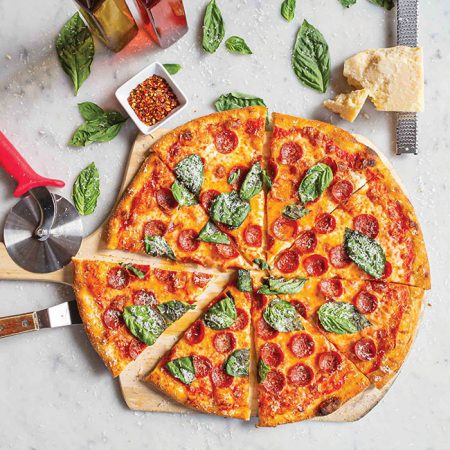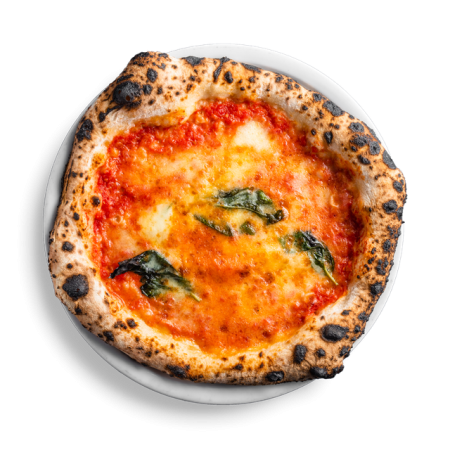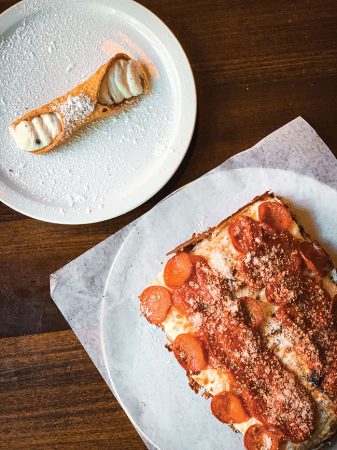
Tried-and-true or in with the new? Pizzerias talk menu
By Andrew Hind
Features Business and Operations TrendsThree experienced pizzerias weigh in on strategy, comfort food and new innovations
 Pizzeria Libretto has launched two new pizza offerings during the pandemic: a Sicilian pizza and
Neo-NY-style pizza (pictured). PHOTO BY PAULINE YU, COURTESY LIBRETTO restaurant group.
Pizzeria Libretto has launched two new pizza offerings during the pandemic: a Sicilian pizza and
Neo-NY-style pizza (pictured). PHOTO BY PAULINE YU, COURTESY LIBRETTO restaurant group. The novel coronavirus global pandemic is quickly reshaping Canadian life as we know it. No customer-facing business – retail, restaurant, services – is unaffected.
Restaurant owners, pizzerias naturally among them, especially face challenges due to restrictions on gatherings of people, the need for new business models, the potential for new localized quarantines, and just the fearful atmosphere that has patrons concerned about dine-in options.
Nevertheless, people still have to eat. The inherent craving for restaurant fare will provide the opportunity for pizzerias to endure, despite the increase in home cooking that we’ve seen over the last six months. There are different paths to thriving in the new reality. Some are sticking to the tried-and-true, featuring comfort foods, while others are opting for innovative new products in attempts to attract customers and keep it interesting.

Margherita pizzas top the list of most popular items on the menu at Toronto’s Pizzeria Via Mercanti. PHOTO: PIZZERIA VIA MERCANTI
Tried and true
During uncertain times, a little comfort food can go a long way. Restaurants around the world have pivoted their dining focus to menus meant to soothe the soul in the wake of COVID-19, and the venture’s been surprisingly successful – both for the restaurants and the customers.
“Our pizza is simple, like the old days and with the best ingredients,” explains Brittany Leo, who works alongside her parents – Romualdo Salvati, a renowned Pizzaiolo, and Robin Leo – at Pizzeria Via Mercanti, the Toronto restaurant they founded in 2012. Pizzeria Via Mercanti won Best in Chow’s hit show Pizza Wars, was featured on Food Network’s You Gotta Eat Here! and has since expanded to three locations. Clearly the family knows a things a thing or two about pleasing its customers.
“There’s something important in preserving the simplicity of food. Where all these exciting new fusions are arising, we still feel there is a strong importance to our simple cuisine. Simple does not mean you miss out on a mouthwatering experience. Quality goes a long way,” Leo says. “This is especially true now, during the pandemic. Many of our menu items, pizza included, are considered comfort foods that resort back to our roots and generate a sense of home and belonging. During uncertain times like these, resorting to comforting, familiar foods is helping people to endure.”
Indeed, remaining true to familiar foods has helped Pizzeria Via Mercanti to endure as well. The restaurant has remained open throughout the pandemic and the menu has remained consistent: only a few items did not survive the impact of COVID-19. Despite boasting a wide range of delicious pastas, the menu’s two most popular items are the Ciambella Ripiena – a margherita pizza that features a ricotta-stuffed crust, hot soppressata and black pepper – and Via Mercanti pizza, both long mainstays.
Longing for comfort food isn’t merely anecdotal, and it certainly isn’t limited to Pizzeria Via Mercanti’s customers. Polls show that 69 per cent of consumers have ordered take-out or delivery food from restaurants during the pandemic, and that 87 per cent of respondents have ordered take-out from a specific local restaurant out of a desire to support the restaurant financially. Pizza represents the top choice among restaurant types for take-out, with 71 per cent of respondents having ordered from a pizzeria at least once since the pandemic hit.
This data suggests that pizzerias can appeal to the sentimental side of consumers by providing food that comforts in troubled times and introducing them to the owner behind their favourite restaurant.
“We’ve managed to survive the 2020 pandemic thus far by staying true to our roots,” Leo says. “Italian culture and cuisine create an atmosphere of love, which is something the whole world needs to feel right now.”

In July, after months of perfecting the recipe, Brigade pizzeria in Montreal launched a Detroit-style pizza in response to what they saw as customer demand. PHOTO: BRIGADE
In with the new
The restaurant industry as a whole has been taking note of our willingness to dine indoors in the last months and keeping track of how our purchasing habits have changed. If any restaurant wants to survive the pandemic, it has to observe what the customer wants and quickly pivot.
Pizzeria Libretto, a revered chain of Toronto pizzerias with five locations, has been responding in unique fashion: doubling down on tried-and-true comfort foods while also experimenting with innovative and exciting new options.
“We’ve pivoted our business to be mostly pizza focused and eliminated some of the more costly and labour-intensive appetizers,” explains Rocco Agostino, executive chef and partner of the Libretto Restaurant Group. “One successful venture has seen us perfect a pan-cooked frozen Neapolitan pizza which can be found in small grocers and Pustaries all across the GTA. This is a challenging time, and we don’t know what the future holds, so by pivoting our business to focus on take-out/delivery and grocery stores we know that whatever we are hit with, we’ll be able to persevere.
Agostino stresses that now is the time to analyze any problem areas in one’s business that are too costly, too inefficient or simply not practical in the midst of a pandemic. Instead, one needs to focus on core, profitable areas of the business. That doesn’t mean, however, that innovation comes to an end. Libretto has launched two new pizza offerings during the pandemic: a Sicilian pizza and Neo-NY-style pizza.
“Sicilian pizza, or square pizza, is what I grew up on as a kid. Our Sicilian is a bit of a hybrid dough, where we treat it like a focaccia, some bulk fermentation, and then bake it in a treated square pan. This gives it a light and fluffy interior and crispiness outside with a frico crust,” Agostino explains. “The Sicilian travels better for take-out and delivery, which is a big component in the post-COVID world.”
Agostino put his own spin on the traditional New York pizza by using a sourdough ferment and baking it in a stone deck oven, which gives it a much crispier texture while still maintaining the blisters that you would get from a pizza baked in a wood oven. “This large pizza is definitely meant for sharing,” Agostino says, “and also is great for take-out and delivery as the longer bake helps retain the heat.”
Brigade, a successful Montreal pizzeria opened in 2014 by partners – in business and in marriage – Grace Yeh and Jean-Daniel Nadeau, also has taken the time to review its offerings and unveil new offerings to fill very specific niches.
“Your core business must remain first and foremost in your mind at all times,” Nadeau says. “You cannot neglect that, or you risk alienating your customer base. You have to ensure your core business remains at the top of its game. When you launch a new product, you have to bring that same excellence to it that your core product is known for and it has to fill a niche. The new product needs to stand out. You can’t just add for the sake of adding.”
Brigade has always been known for Neapolitan pizza cooked in a wood-fire stove (both Nadeau and Yeh and certified pizzaiolos by VPN, the Vera Pizza Napoletana Association). That’s their core business. But in July, after months of perfecting the recipe, they launched a Detroit-style pizza in response to what they saw as customer demand. “Our customers wanted something different,” Nadeau explains. “People are trying to fill their emotions with food, and the Detroit pizza – thicker, heavier, heartier – fits the bill. It’s more decadent than the Neapolitan pizza, perfect for sharing for a partner, and we say an opportunity to set ourselves apart.”
Brigade’s location in downtown Montreal also informed the decision to unveil a Detroit pizza. With a client base consisting largely of office workers who are currently working from home, and likely will be for the foreseeable future, Yeh and Nadeau knew take-out and delivery would become more important to his business model than was previously the case. Thicker and heavier, the Detroit-style pizza transports better and stays warm longer than does the Neapolitan.
The loss of its pre-COVID-19 clientele has forced Brigade to be nimble and innovative. “During the pandemic, when sales plummeted 60-70 per cent, we launched online pizza-making classes wherein we sent kits out to customers and did courses on Zoom,” Nadeau explains. “The need to prepare meals three times a day, seven days a week, was proving stressful for many people. It was a joyless chore. These courses made cooking a meal fun again.”
Food isn’t merely a sustaining requirement of life. It also brings comfort and joy, pleasures that remain as true today as they were before the coronavirus descended upon us. There isn’t a roadmap to success for pizzerias in the pandemic world, but there are avenues you can take.
Tried-and-true or in with the new? It’s up to you.
Andrew Hind is a freelance writer from Bradford, Ont., specializing in food, history and travel. He is the author of 25 books and the proud father of one.
Print this page